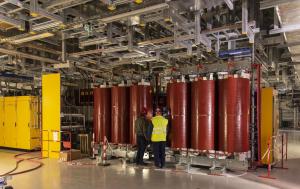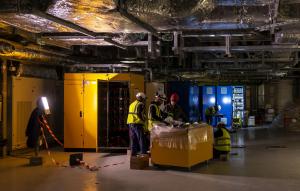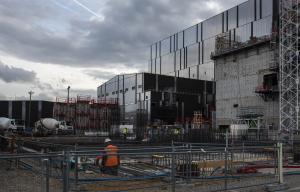Installing the first power supply sets
When the plasma in the ITER vacuum vessel is fed sufficient power, the velocity that the particles acquire causes them to collide, fuse and generate considerable amounts of energy. Particle velocity in the plasma can be expressed as temperature: in a deuterium-tritium plasma, the temperature threshold at which fusion reactions occur is in the range of 150 million degrees Celsius. To achieve such extreme temperature in the core of the plasma, ITER will rely on three external heating systems: neutral beam injection, electron cyclotron resonance heating (ECRH) and ion cyclotron resonance heating (ICRH). In the Radio Frequency Building, standing against the northeast side of the Assembly Hall, equipment installation for the ECRH system has begun.
An ECRH installation is based on the same principle as that of a microwave oven: electrical power is converted into electromagnetic waves whose frequency matches the oscillations of the particles in a given environment—a matching called "resonance." In the kitchen, the frequency is calibrated for water molecules; in ITER the ECRH system is designed to resonate with the electrons in the plasma. Another difference of course is size and power: whereas a kitchen microwave oven delivers 700 to 800 watts to the bowl of soup or frozen pizza placed inside it, the ITER ECRH system will feed 20 million watts (20 MW) to the plasma, which happens to be more than one hundred metres distant from the wave-generating equipment.
The ECRH system occupies about half of the available surface in the three-level Radio Frequency Building, which is 50 metres long, 43 metres wide, and 25 metres high. (The other half of the building is reserved for ICRH equipment, whose installation has not yet started.) The uppermost level will accommodate 24 ECRH devices, called gyrotrons, that generate the electromagnetic waves, as well as the set of transmission lines ("waveguides") that will deliver them to the plasma.
Gyrotrons are high-tech components that took close to two decades to develop and bring up to ITER requirements. They are procured by Japan (2 out of 8 delivered), Russia (4 out of 8 delivered), Europe (4) and India (4). US ITER has finalized the design of the transmission lines (4 km in total) and manufacturing is set to begin.
Gyrotron performance depends heavily on the "quality" of the electrical current that powers them: dynamics and accuracy on the output voltage are key for their optimal performance. On the floors below the gyrotrons, 12 sets of high-voltage power supplies will be installed to convert 22 kV AC current to the high-voltage DC current (55 kV-110 A) required. Procurement of the power supplies is shared between Europe (8) and India (4). European contractor Ampegon, a Swiss company, designed and manufactured the power supply systems of the European and Russian gyrotrons and is presently installing the second of the eight European sets.
During its first phase of operation, ITER will rely on ECRH heating (and not even all of its capacity). As ICRH and neutral beam systems are progressively installed and commissioned, ITER will acquire the heating power required to initiate fusion reactions in the deuterium-tritium plasma.




